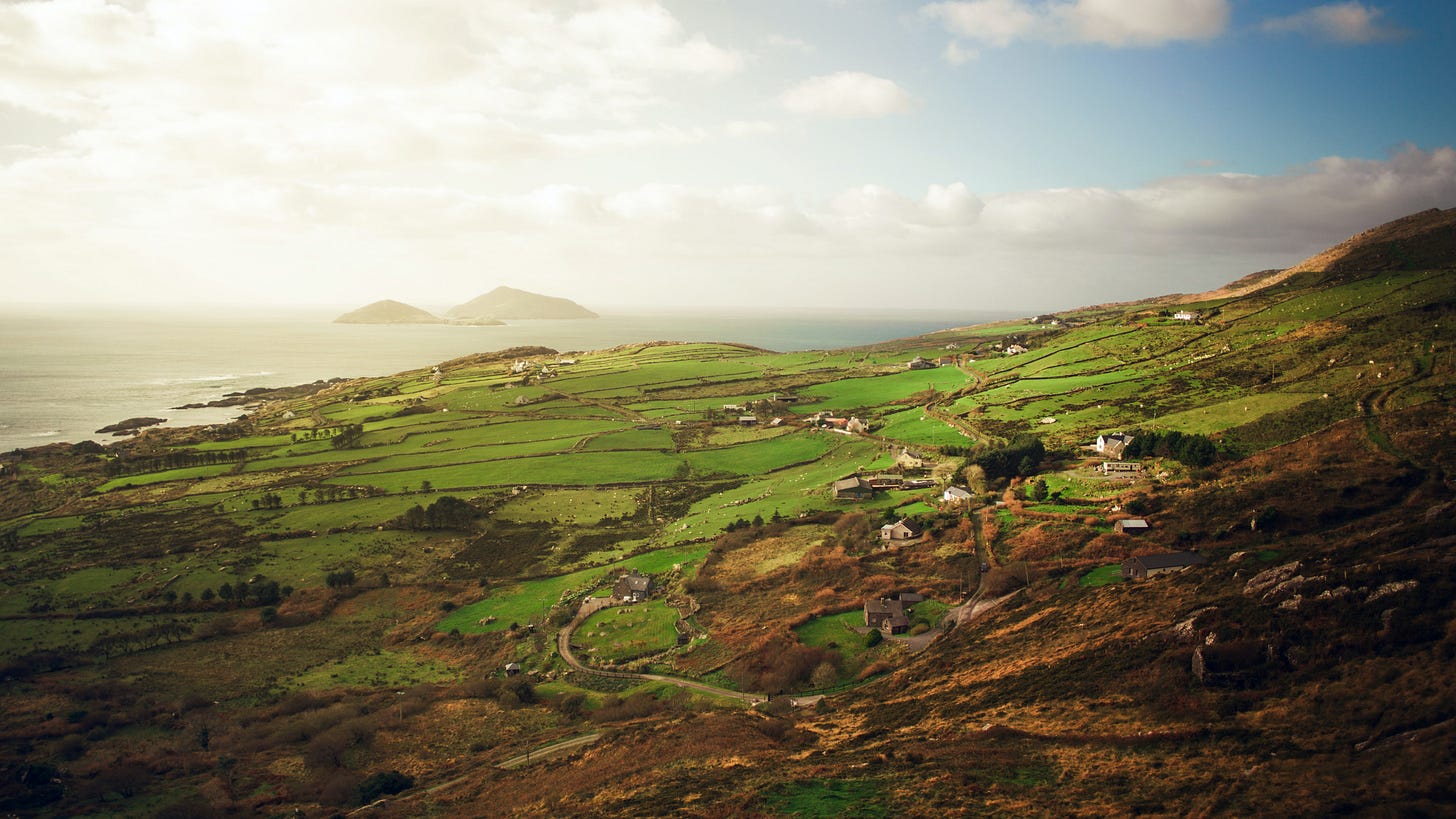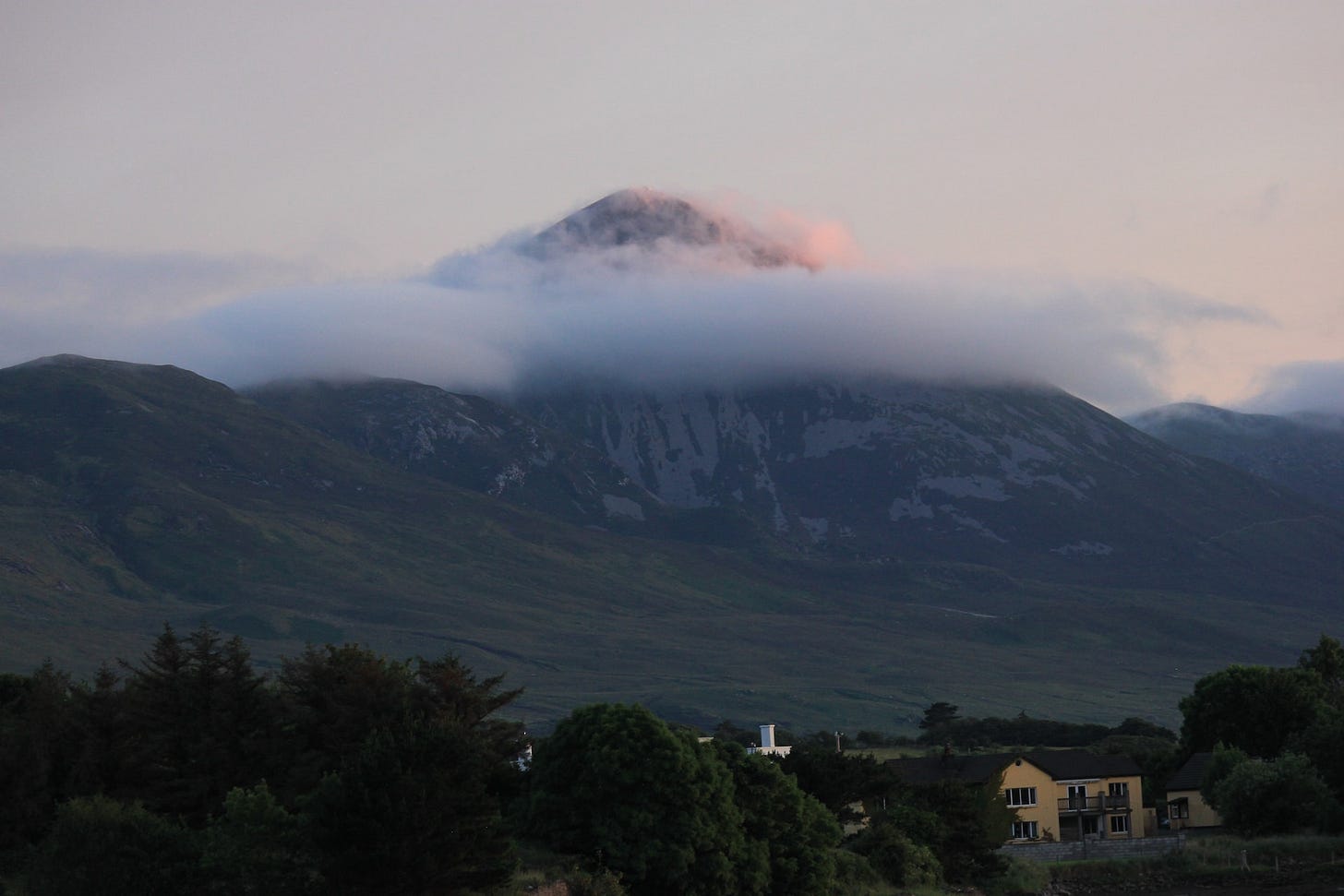We were a week out from Brexit when the bus crossed the border. Everything was green, and everything was grey, and so it was on the other side too. The policemen boarded to check our credentials and I realised why people were worried about the Irish border reverting to the old ways. It used to be all soldiers and smugglers and trouble and Troubles, but when the police walked up to me I said G’day and gave them an Irish passport that in no way matched my Australian accent. They thanked me without checking the photo and moved on to the woman in front of me; Russian, I think. She held up her credit card as identification. Names and words that nobody could read or pronounce, but still, the police thanked her and moved on. It was all too easy.

We had left Belfast that morning and were heading south to Dublin before travelling cross country to the Atlantic Coast. And I quickly learned that a trip across Ireland means a front-row seat to the physical manifestation of whatever gods there are. It means the greenest grass and crumbling walls and springtime lambs that are old enough to explore the paddock but too young to understand that they’ll never go further. It means travelling through towns with more pubs than people, towns with names like Ballindooley and Corrandulla, and it means strolling the Salt Hill Prom in search of a Galway Girl but drowning in a sea of Americans instead.
In fact, the only way that you can tell you’ve made it to the real Ireland is when you’re surrounded by Americans. They’ll be dressed in tweed hats and green shirts. They’ll shout across the bar and say things like, ‘The Guinness just tastes better here!’ They’ll try to explain that New York City is between Ireland and Kansas like anyone actually gives a shit because we’re not in Kansas anymore Dorothy, or Doireann, or whatever your name is. Over 30 million Americans identify as Irish and, at any given moment, 90% of them can be found in a Galway pub.
A trip across Ireland means walking from Westport, County Mayo, to the base of Croagh Patrick, Ireland’s holiest mountain, and being greeted by a priest as he descends from his morning prayers. Saint Patrick fasted atop this peak for forty days before driving away the island’s snakes and I was there to do something similar. Not that I wanted to fast, of course. Nor did I have beef with the long-departed snake population. I suppose I was there for the same reasons as the Americans. I was Patrick – hell, I still am – and I wanted to climb Patrick’s mountain. I wanted to honour my roots, to reach new heights and discover something familiar. I wanted to tap into some kind of ancestral wisdom. I wanted, at the very least, to get a nice picture for Instagram.
Though the climb wasn’t technical, it was oh so slippery. It was wet and bleak but so is everything in Ireland. Towards the top, the trail twisted around the back of the mountain and turned into seemingly endless scree. The wind whipped across the green and brown fields to the east, a wind that pushed me up and down and sideways over boulders and pebbles and the occasional orphaned glove. These gloves beckoned me closer. These gloves were calling me home.
Trudge.
Trudge.
Trudge.
I trudged onwards and upwards and into the fog on a gradient of 60 degrees. It might’ve been 70 degrees, maybe even 90, I don’t know. When recounting the experience to some Americans later that night, I would tell them this: ‘It was straight-up vertical in a freaking blizzard, man. The real Ireland y’know?’

My fellow pilgrims were kneeling and praying and walking barefoot. They said seven Our Fathers and nineteen Hail Marys and sipped the blood of Christ from a can of Guinness. They sang out Van Morrison as they cartwheeled towards a pot of gold at rainbow’s end. They were connecting with something bigger than any of us. They were finding themselves on top of Croagh Patrick and before long I was too; geographically, at least.
I couldn’t see anything and could’ve been anywhere. I could’ve been everywhere – as Saint Pat surely is – but a sign informed me that I was indeed on top of Ireland’s holiest mountain. Saint Paddy managed six weeks here as his demons tormented him in the form of blackbirds. I endured a mere twenty minutes with my demons rumbling deep in my stomach; either an all-encompassing discontent or the onset of salmonella from the chicken wrap I’d purchased, on special, from the local petrol station. Far from the feeling of enlightenment I’d craved.
Pilgrims and people, the faithful and unfaithful, had left offerings on the summit. Rosary beads and prayers and a sodden pack of cigarettes; menthols, I think. A bright-green comb and a matchbox car and photos of relatives who were dead and living and dying. I had little to give and there was little to take, so I departed the summit as I’d arrived: empty-handed. On the way down I passed a young couple zig-zagging left and right up the scree slope. The guy saw me and called out in this pained American accent, ‘Man, how much further does this freaking thing go for?’
I realised then that I was the first person – aside from the priest – to come back down the mountain that day. I realised then that I was, for all intents and purposes, all-seeing and all-knowing. I may as well have been Saint Paddy himself, so I breathed deeply, sought guidance from the heavens and said something like, ‘Have patience, my child.’
I told them that the summit was around the corner and worth the climb for the view. I floated down the mountain as they sweated and strained and swore their way towards the top. I passed more people, more pilgrims. Those who were climbing the mountain to be closer to God and further from their problems. I blessed them with my knowledge of the path – The Path, rather – and warned these older British guys that it’s tough on the knees. They began arguing about Terry and whether he would make it. I then saw Terry limping along the path to salvation with his head down, his lips and jacket both zipped tight.
Towards the bottom of the mountain, after the first real incline, I came across a man sitting on a boulder and he did not look happy about it. ‘Hello,’ I said, and he said nothing. His partner struggled up the path behind him in tears. ‘Hello,’ I said, and she said nothing. She didn’t look happy about anything.
I thought: it’ll be a miracle if they make it to the summit.
Then I thought: it’ll be a miracle if they make it at all.
But little miracles are everywhere, so I did what anyone would do: I prayed for them. ‘You’ll be right,’ I whispered, and by the time I bottomed out they were together again, walking hand-in-hand, a little miracle making its way up a magical mountain.
A little miracle, I thought, like the clouds parting to reveal the summit.
A little miracle, I thought, like five friends in their seventies still bagging peaks.
A little miracle, I thought, like an American accent cutting through the fiddles and flutes of a packed rural pub to remind us that we’re there – that we’re here – for the very same reason.
A little miracle, I thought, like avoiding salmonella after a cheap chicken wrap.
A little miracle, I thought.
Like the real Ireland, y’know?
A version of this story was published by Pilgrim Magazine in 2019.
You may have noticed that P&P offers a paid subscription option. This works as a kind of tip jar, I suppose, so if you’d like to offer monetary support, please consider becoming a paid subscriber below. For now there is no difference in what you receive as a free or paid subscriber; either way, you’re appreciated. Thanks again for being here.





